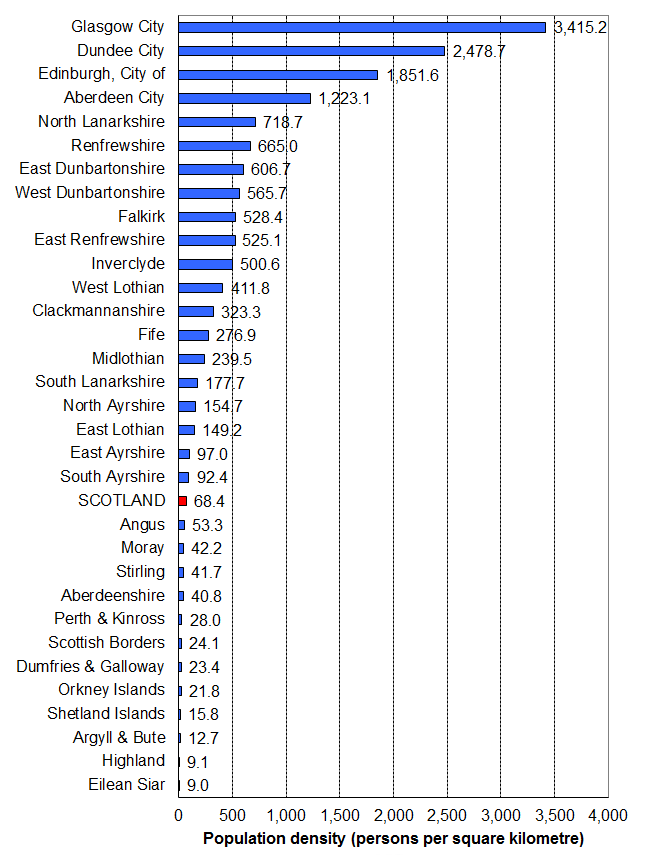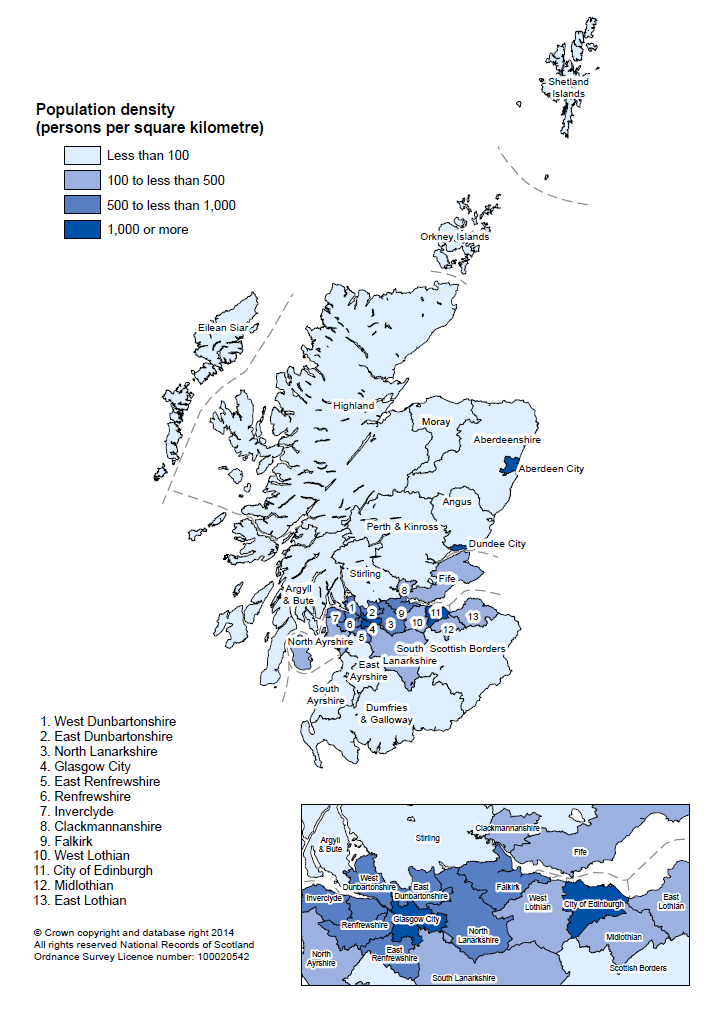4.1.1 Population estimates for each Council and NHS Board area, together with details of the components of population change (births, deaths, net migration and other changes) for the period mid-2012 to mid-2013, are shown in Table 4.
4.1.2 Among Council areas, the largest percentage population increases occurred in Moray (+1.5 per cent), Argyll & Bute (+1.3 per cent) and the City of Edinburgh and Aberdeen City (both +1.0 per cent). The increases in Moray and Argyll & Bute are mostly due to increases in the number of armed forces in these areas.
4.1.3 Eleven Council areas experienced a decrease in population. The largest percentage decreases occurred in West Dunbartonshire and Eilean Siar (both -0.6 per cent), North Ayrshire and Inverclyde (both -0.5 per cent) and Dumfries & Galloway (-0.4 per cent).
4.1.4 Of NHS Board areas, Grampian had the largest percentage population increase (+1.0 per cent), followed by Lothian (+0.7 per cent) and Highland (+0.4 per cent). Four NHS Board areas experienced a decline in population with Western Isles having the largest decrease (-0.6 per cent), followed by Dumfries & Galloway (-0.4 per cent), Ayrshire & Arran (-0.3 per cent) and Shetland (-0.0 per cent).
4.2.1 For most areas, the main cause of population change from mid-2012 to mid-2013 was migration. Table 5 shows migration flows to and from each Council and NHS Board area for people moving within Scotland (i.e. between one Council area and another or between one NHS Board area and another), people moving between Scotland and the rest of the UK and people moving between Scotland and overseas.
4.3.1 As Figure 7 shows, in-migration is greater than out-migration in the majority of Council areas contributing to positive net migration. However, in most areas the difference is not large. Council areas with the largest percentage of in-migrants such as Aberdeen City (6.2 per cent), the City of Edinburgh (5.7 per cent) and Stirling (5.5 per cent) also have a comparatively large percentage of out-migrants.
4.3.2 In other Council areas the number of out-migrants was greater than the number of in-migrants resulting in a net migration loss. The net losses were largest in West Dunbartonshire, North Lanarkshire and West Lothian, where there were approximately 400 more out-migrants than in-migrants.

4.3.3 As Figure 8a shows, different Council areas attract migrants from different areas. In all but two Council areas (namely the City of Edinburgh and Dumfries & Galloway) most of the migrants came from other Council areas within Scotland. For example, of the 3,660 people estimated to have arrived in East Renfrewshire, 3,161 (about 86 per cent) were from elsewhere in Scotland, 409 (about 11 per cent) were from the rest of the UK and 89 (about 2 per cent) were from overseas.

4.3.4 In the City of Edinburgh and Dumfries & Galloway more than half of the in-migrants came from outside Scotland with most of these coming from the rest of the UK.
4.3.5 The number of in-migrants from overseas exceeded the number of in-migrants from the rest of the UK in only two Council areas, Aberdeen City and Glasgow City.
4.3.6 As Figure 8b shows, there are also differences in the destinations of people migrating out of Council areas. Often the region to which most out-migrants moved was the same region from which most in-migrants had arrived. For example most of the migrants leaving East Renfrewshire, Midlothian and East Dunbartonshire moved elsewhere in Scotland and, as already described, most of the migrants arriving in these Council areas came from elsewhere in Scotland. Similarly, more than half of the migrants leaving the City of Edinburgh and Dumfries & Galloway moved outwith Scotland, with most of them moving to the rest of the UK.

4.4.1 As Table 5 shows, some Council areas experienced net gains from one region but net losses to another.
4.4.2 West Lothian was the only area to experience net losses of people to all regions (within Scotland, the rest of the UK and overseas), while Aberdeenshire was the only area to have a net gain of people from all regions.
4.4.3 The city authorities tended to lose migrants to other areas of Scotland but gain from the rest of the UK and overseas. For example, there was a net gain of 3,032 migrants in the City of Edinburgh - comprising net losses of 606 people to the rest of Scotland and net gains of 1,680 and 1,958 people from the rest of the UK and overseas, respectively.
4.5.1 There were more women than men in Scotland in mid-2013. This was the case for all Council areas other than Shetland Islands and for all NHS Board areas other than Shetland. Table 7 shows the sex ratio for each Council and NHS Board area in Scotland for mid-2013. The sex ratio is the male population divided by the female population (e.g. a sex ratio of 0.95 means that for every 100 females there are 95 males). The sex ratio ranged from 0.91 in West Dunbartonshire to 1.03 in Shetland Islands. For the NHS Board areas, the sex ratio ranged from 0.92 in Ayrshire & Arran to 1.03 in Shetland. Figure 9 shows how the sex ratio varies for Council areas across Scotland.
4.5.2 The main reason for there being more women than men in Scotland is due to the longer life expectancy of women. Other reasons for differences in the proportions of men and women in areas of Scotland may relate to migration and employment, for example in areas with armed forces bases or oil industry work.

4.5.3 Although the pattern of age distribution is complex, some general themes can be seen from Table 7. Most city Council areas had a high proportion of men and women of working age. For example, in Aberdeen City 72 per cent of men and 66 per cent of women were of working age compared with 66 per cent of men and 60 per cent of women for all of Scotland. The highest proportions of people of state pension age tended to be in more rural Council areas such as Argyll & Bute (21 per cent of men and 31 per cent of women) and Dumfries & Galloway (22 per cent of men and 29 per cent of women). In Scotland as a whole, 16 per cent of men and 23 per cent of women were of pensionable age1.
4.5.4 These patterns can also be seen in Figure 10 and Figure 11 which show the proportion of the population aged under 16, 16-64, and 65 and over for Council and NHS Board areas respectively (ranked by the proportion of the population aged 65 and over).


4.6.1 Land areas and population densities for mid-2013 are shown in Table 9. The mid-2013 population density for Scotland was 68 people per square kilometre and ranged from nine people per square kilometre in Eilean Siar to 3,415 people per square kilometre in Glasgow City. For comparison, the average population density for the UK at mid-20122 was 263 people per square kilometre. Land areas used for calculating population densities are based on the latest Standard Area Measurements produced by the Office for National Statistics.
4.6.2 Figure 12a and Figure 12b provide information on population densities for mid-2013.

 Footnotes:
Footnotes: